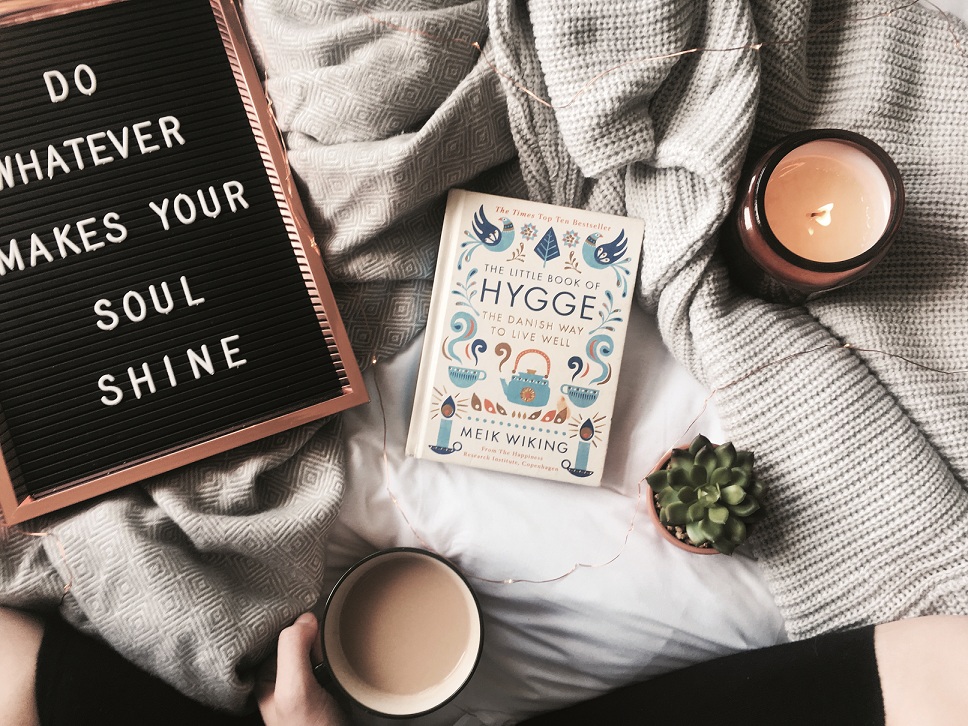
The sound of rain tapping against the window while sitting with a favourite book in the familiar surroundings of a warm living room. The smell of wet autumn leaves picked from the morning’s walk and muddy boots lain at the door showing signs of adventure. Dark and steaming coffee swirling around in a cup while warming the hands wrapped around it. Curled up with the dog amongst endless cushions, a knitted blanket across your feet adorned in woolly socks.
This is hygge (pronounced “hoo-gah”).Well, minus a beautiful, roaring fireplace *sigh*.
Norwegian in origin and more recently popularised through Danish culture, translations of hygge range from hugge meaning ‘to embrace’ to Old Norse hugga meaning ‘to comfort’ derived from hugr meaning ‘mood’. With multiple definitions, today we can place the term hygge in that of ‘wellbeing’; a multidimensional and valuable concept evermore important in ours and our children’s lives.
Hygge is a feeling, an atmosphere and an experience rather than anything material. It is a feeling of community, belonging, love and home. We waste so much time as parents and educators worrying about our children’s achievement, what grades they come home with or which university they may attend that we forget to focus instead on more important things like our children’s happiness. A child’s wellbeing is central to happiness and without it they will struggle to achieve. This is where hygge can help.
Create an Atmosphere
With more screen time and exposure to artificial light, our brains are over stimulated. Natural light provides respite for our brains and is proven in treating anxiety and depression. Open those curtains in the day and remove items that block the natural light. Come the evening, embrace the glow of a few lamps to create pockets of light rather than the main overpowering ceiling light. To create a feeling of warmth, light a candle or two while talking with your child about safety but also the meaning and significance of light. In your home, natural colours and textures help to connect us with the natural world and exude comfort. A blanket on the sofa to throw on our laps, or a pillow on the floor to sit on during discussions helps to create this atmosphere. However, there is also opportunity to practise minimalism; to not over-clutter our homes but fill them with items which have meaning and purpose.
Savour and Indulge
Food has a wonderful way of bringing us together. From the fun of baking cakes with the children, to gatherings around a table for a hearty meal, food is a cornerstone to building healthy relationships and a feeling of security with the ones we love. Nothing feels more hygge than the smell of freshly baked bread from the oven. Exercising pleasure is important. Enjoy the lick of chocolate off of a spoon, the indulgence of a cupcake and the warmth of your hands wrapped around a coffee cup. This is not to suggest that it is suddenly okay to eat unhealthily, but rather to take pleasure in and savour the wonderful moments we can have with food. Hygge is about being mindful and enjoying each of those moments to their fullest.
Enjoy the Outdoors
In the modern era we spend less and less time outdoors and amongst nature; which, let’s be honest, is really quite sad. A fundamental aspect of hygge is to embrace the outdoors, to feel the wind and rain on your skin. Alfred Wainwright once wrote “there’s no such thing as bad weather, only unsuitable clothing” in his 1973 book, “Coast to Coast”. So, with that in mind, grab your waterproofs and wellies and head outside (if you don’t have these, get yourself on Taobao and get that sorted pronto).
A walk in the park or simply an evening wander around your local neighbourhood will do wonders for your child’s health and well-being… and yours, for that matter! When home, embrace the soft touch of cosy pyjamas, a knitted jumper and thick woolly socks as you reminisce about your outdoor adventures.
Quality Time with Loved Ones
As social beings we thrive off of building relationships with others. They are a cornerstone to happiness. To achieve this, we must make time for each other. Forging traditions with your family, such as Sunday dinners, Saturday craft afternoons or Friday night boardgames, is a wonderful way to create a feeling of hygge. We must appreciate the ‘we’ more than ‘me’. It’s not a time for egos but to share a common harmony. Turn off the phones and devices; this will enable you all to engage with the present moment and be able to share stories of your life and experiences with your children. The simplicity of a happy memory can be felt when shared with your child and invites them to share happy memories too. It inspires us to create more of them in times to come. This is a place of authenticity and security; to be comfortable around the ones you love.
In today’s frantic, fast-paced, screen-addicted world, it is easy to lose oneself. We need to value and connect with the world and each other through meaningful experiences. To exercise gratitude in our daily lives and make ordinary moments extraordinary. Slow down, take time to be together and enjoy the simple, humble pleasures of life. Thoughtful and purposeful relaxation, hygge does wonders for your child’s well-being which they will carry long into their happy futures.
Hygge is a feeling, an atmosphere and an experience rather than anything material. It is a feeling of community, belonging, love, and home. We waste so much time as parents and educators worrying about children’s achievement... that we forget to focus instead on more important things like our children’s happiness.
Good to know
'The Little Book of Hygge:
The Danish Way to Live Well'
By Meik Wiking